|
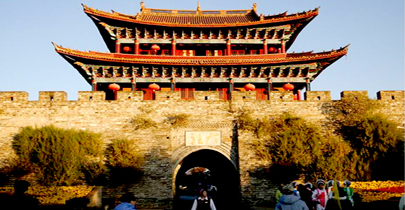 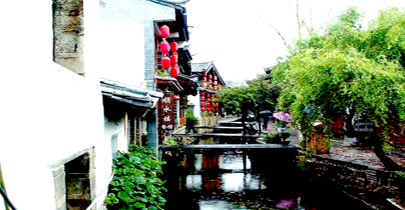
Overview
'Dali' in Chinese means 'marble', because it is the home of marble. Dali is a city 400 km west of Kunming. It is located between the Erhai Lake and the Cangshan Mountain. The Cangshan Mountain with 19 peaks stands here like a silver screen. The highest peak is 4120 meters above sea level and the whole mountain range runs as long as 50km. The Erhai Lake looks like a mirror dotted with floating boats on its rippling surface.
The Erhai Park on the southern shore provides visitors with its ancient-style pavilions, corridors and platforms where one can take a panoramic view of the Cangshan Mountain and the Erhai Lake. The Butterfly Spring is another frequent destination of tourist in Dali. The clear water and the flying butterflies give people a sense of tranquility and mystery.
Dali is noted for its glorious history and culture. Built in the 9th century, the three majestic pagoda of Cangshan Temple present a typical architectural style of ancient China. The stone Dehua Tablet of Nanzhao Kingdom is a very important historical relic for searching the history of the Tang Dynasty and the Nanzhao Kingdom. Another important historical relic is the Stone Tablet Commemorating Kublai Khan's Conquest of Yunnan. This tablet is the earliest record about the establishment of Yuannan Province by Kublai Khan.
In history, Dali used to be one of the important posts on the road to india and Myanmar. It was once a very prosperous town for cultural and economic exchanges between China and Southeast Asian countries. Both the well-known Chinese geographer Xu Xiake and the italian traveler Marco Polo visited Dali and described it in their Travels.
Today, Constructions in Dali are scattered in a chessboard-like fashion. Part of the city walls is perfectly preserved. The roads are paved with gray flagstone. The local dwelling houses are typical of the architecture of the ethnic Bai group.
Attractions
Ancient Dali Town 
Located between Erhai Lake and Cangshan Mountain, Dali old town is 13 km away from Xiaguan, the new urban area. Right here tourists can find the relaxing atmosphere and laid-back pace of life.Many international backpackers have regarded it as a Mecca to tune out for a while.
In History, Dali was also called Yeyu, and Purple City. The circumference of Dali Ancient City is 6 kilometers long. The city wall is 8 meters high and 7 meters thick. The interior of the wall was filled with rocks and the surface was bricked over smoothly. The four gate towers in the east, south, west and north are named Tong Hai, Chen En, Cang Shan and An Yuan respectively. From 8th to 13th century, it was the capital of Nanzhao and Dali Kingdoms and the political center of Yunnan and nearby area. The old city wall was first built in 1382 during the Ming Dynasty (1368-1644). In 1982, Dali was added in the top historical cities of China.
Walking in the cobbled streets of Dali, you will get a feel of relaxed atmosphere. Handicraft shops and restaurants are lined up along the way. Huguo Road is the main strip for cafes ? locals call it 'Foreigner’s Street', where you can enjoy the western coffee, pizza, sandwich and other treats.
The Cangshan Mountain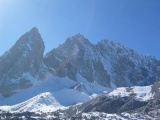
Consisting of 19 peaks and 18 streams in total, the Cangshan Mountain is located about 2 km to the west of the Dali city. The Horse and Dragon Peak (Malong Peak), the highest one, towers 4,122 meters above sea level and the mountain top is covered with snow all year round. The 18 streams flow down from the mountain valleys and empty themselves at Eihai Lake, which become the major water source for the lake.
For centuries, the Cangshan Mountain not only offers tourists enchanting scenery, but also a place for religious worship and retreat. Tourists can take a cable car and horse back ride up to the mountain slopes, where some Buddhist temples are scattered in the mountain range. People can walk along the flat road on the mountain, and enjoy the spectacular view of Erhai Lake and other scenic spots.
The mountains are covered with green trees and tea bushes. The area produces more than 100,000 kilograms of processed tea annually and is the home to the famous Yunnan White Tea. Having been quarried in the mountain for over 1,300 years, Dali Marble has been widely accepted as a high-profile construction and ornamental material in China.
Erhai Lake
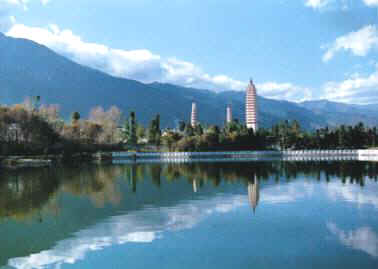 With an altitude of 1972 meters above sea level, Erhai Lake is a beautiful highland lake of Yunnan Province and one of the seven largest fresh water lakes in China. As it shapes like an ear, and wave like a sea, the locals named it 'Erhai' ? Ear Sea in Chinese language. 2 km east of Dali, the lake encompasses an area of 250 square kilometers, with 40 km long from south to north, 7-9 km wide from east to west. Its circumference reaches 116 km, its average depth is of 11 m and the total storage capacity of 2.5 billion m³ With an altitude of 1972 meters above sea level, Erhai Lake is a beautiful highland lake of Yunnan Province and one of the seven largest fresh water lakes in China. As it shapes like an ear, and wave like a sea, the locals named it 'Erhai' ? Ear Sea in Chinese language. 2 km east of Dali, the lake encompasses an area of 250 square kilometers, with 40 km long from south to north, 7-9 km wide from east to west. Its circumference reaches 116 km, its average depth is of 11 m and the total storage capacity of 2.5 billion m³
.
The Three Pagodas of Chongsheng Temple 
A couple of kilometers northwest of Dali old town, the Three Pagodas of Chongsheng Temple are the oldest standing structures in Yunnan, which has become the emblem of Dali. With Cangshan Mountain in the background, the majestic towers stand on a hill and are visible from almost any vantage point within Dali and the surrounding area.
The tallest of the three, Qianxun Pagoda, has 16 tiers that reach a height of 69.13 meters. It was first built in the period 824 - 839 in the Tang Dynasty. It is flanked by two smaller 10-tierd pagodas, which are 42.19 meters each. In 1978, a renovation project was launched. 618 pieces of valuable antiques were found in the pagodas, including Buddhist scriptures, statues, musical instruments and copper mirrors of Tang and Song Dynasties.
Dining
In Dali old town, you will see many nice restaurants, which are mainly located at Huguo Road and Remin Roa d, serving both Chinese, Western food as well as local Bai's cuisine. Bai people enjoy spicy, sour and fresh dishes. For the new comers, even a little bit local spice may make your tongue burn. In history, Chinese Han culture and Buddhism had an important impact on the development of Bai cuisine. d, serving both Chinese, Western food as well as local Bai's cuisine. Bai people enjoy spicy, sour and fresh dishes. For the new comers, even a little bit local spice may make your tongue burn. In history, Chinese Han culture and Buddhism had an important impact on the development of Bai cuisine.
The most popular drink of Bai people is tea. The Three-course Tea is a very interesting tea ceremony, including the three courses of tea with different tastes: bitterness, sweetness and a mixed aftertaste. This can imply a life philosophy: Hardness and bitterness come first, followed by sweetness, finally the life is a mixture of different tastes.
Shopping
The ideal location for shopping in Dali must be Foreigner Street in the Ancient City of Dali. This street exhibits an abundance of local specialties. In the dwelling area of the Bai minority group, characteristic handicraft articles of the Bai people can be purchased. Furthermore, supermarkets and shopping malls can also meet visitors' daily necessities.
Dali Snow Pear
Owing to the climate and the soil condition of Dali, the pears which grow here are much sweeter in flavor, and have thinner skins and more tender flesh. The main growing area for Dali snow pears is on the eastern side of Erhai Lake. Every August and September in the harvest season, people come from all around to Erhai Lake to pick pears and celebrate the harvest.
Engraved Green Plum
A traditional food of the Bai people is made from dried green plums. These are engraved with various patterns and designs. The fruit can be eaten after months spent soaking in pickling juice made from salt, brown sugar and honey. Having the dual effects of promoting the production of bodily fluids and relieving thirst, as well as displaying artistry, the engraved green plum fruit is both a popular food and a delicate work of art.
The Compressed Tea (Tuo Cha) of Xia Guan
Due to it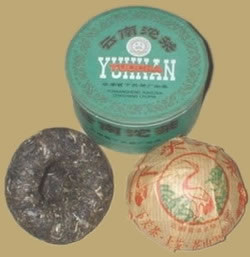 s resemblance to the shape of a fungus, the compressed tea of Xia Guan is called 'Tuo Cha'. It enjoys an excellent reputation for its fragrance and cleansing effects. Xiaguan can promote health by refreshing both body and mind and is also an excellent method used for weight-loss. s resemblance to the shape of a fungus, the compressed tea of Xia Guan is called 'Tuo Cha'. It enjoys an excellent reputation for its fragrance and cleansing effects. Xiaguan can promote health by refreshing both body and mind and is also an excellent method used for weight-loss.
Tie-dye 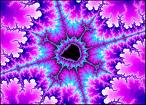
The tie-dye of the Bai Minority is usually made by stitching patterns on cotton cloth and impregnating them in plant dye. Traditional dyed fabrics have white patterns on a background of indigo and are used for tablecloths, door curtains, hats, clothes, and scarves as well as other items. In Zhoucheng Village, there are many family workshops which make dyed fabrics. Visitors can take minibuses and carriages to the village.
|